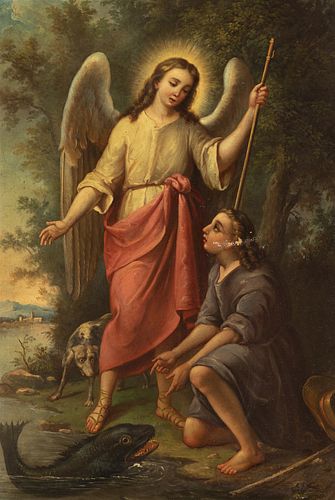Spanish School; 1850. "Tobias and the Archangel Saint Raphael". Oil on canvas.
Lot 71
About Seller
Setdart Auction House
Carrer Aragó 346
Barcelona
Spain
Setdart Subastas was born in 2004 and is currently the first online art auction in Spain with solidity, prestige and reliability guaranteed by our more than 60,000 users. Setdart has a young, dynamic and enterprising team ready to successfully manage the purchase and sale of art works through custom...Read more
Estimate:
EUR€1,500 - EUR€2,000
$1,562.50 - $2,083.33
Absentee vs Live bid
Two ways to bid:
- Leave a max absentee bid and the platform will bid on your behalf up to your maximum bid during the live auction.
- Bid live during the auction and your bids will be submitted real-time to the auctioneer.
Bid Increments
| Price | Bid Increment |
|---|---|
| EUR€0 | EUR€10 |
| EUR€200 | EUR€25 |
| EUR€500 | EUR€50 |
| EUR€1,000 | EUR€100 |
| EUR€3,000 | EUR€200 |
| EUR€5,000 | EUR€500 |
| EUR€10,000 | EUR€1,000 |
| EUR€20,000 | EUR€2,000 |
| EUR€50,000 | EUR€5,000 |
About Auction
By Setdart Auction House
Nov 3, 2021
Set Reminder
2021-11-03 08:00:00
2021-11-03 08:00:00
America/New_York
Bidsquare
Bidsquare : OLD MASTERS
https://www.bidsquare.com/auctions/setdart-auction-house/old-masters-7786
Setdart Auction House sofia@setdart.com
Setdart Auction House sofia@setdart.com
- Lot Description
Spanish School; 1850. "Tobias and the Archangel Saint Raphael". Oil on canvas. Presents faults and jumps in the painting. Measurements: 70 x 48 cm; 90 x 68 cm (frame). Placed in a leafy landscape and on the bank of a river, two figures appear in the foreground: a winged one, luxuriously dressed, and, next to him, a young man kneeling towards the water. The painting shows the moment when Tobias, following the angel's instructions, is about to tear out the heart and entrails of a huge fish to cure his father's blindness (Book of Tobit: VII, 15). According to the biblical passage, the scene in which Tobias and Raphael stop at Lake Tiberias where Tobias catches the fish that will cure his father's blindness, takes place at sunset. And it is precisely the event of the fishing that is represented in this oil painting, where the golden light of the sunset can be appreciated, reflected in the left area of the composition, where the landscape is open to the horizon. Aesthetically, the clarity of the tones used by the author, who works with a range of pastel colors, as can be seen in the mantle of San Rafael. In addition, it is remarkable the workmanship of the work, which is defined through soft and harmonious features that indicate that it is an aesthetic typical of the nineteenth century. The clarity of the representation, as well as the large size of the figures, the easy identification of the subject represented and the absence of anecdotal elements that distract the viewer are elements introduced in art in the rules imposed by the Council of Trent (1545-1563) to defend the beliefs of Roman Catholicism against the attacks of Protestantism. The notoriety achieved by saints and figures previously less common is due to the criticism of the abundance of saints and their relics that Luther's ideas and their defense unleashed in Europe. In this line, the cult of the Archangels is encouraged, an area in which scenes related to them are inscribed, such as the present work.
- Shipping Info
-
In-house shipping available. Please inquire at admin@setdart.com.
-
- Buyer's Premium



 EUR
EUR CAD
CAD AUD
AUD GBP
GBP MXN
MXN HKD
HKD CNY
CNY MYR
MYR SEK
SEK SGD
SGD CHF
CHF THB
THB

















